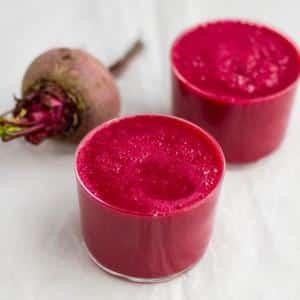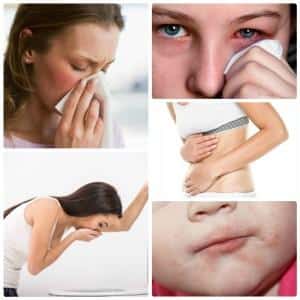How to recognize a beet allergy and quickly get rid of its symptoms: effective medications and traditional methods
Borscht, beet salad with prunes, herring under a fur coat, vegetable stew, vinaigrette, beetroot soup. Everyone has been familiar with these dishes since childhood. Beetroot gives them their brightness and unique taste. It supplies the body with potassium, magnesium, calcium, phosphorus, sulfur, iron, zinc, manganese, boron, chromium, cobalt, vitamins A, B1, B6, B3, B9, C, E. No other vegetable has this combination of substances . The beneficial properties of beets are not lost even during heat treatment.
But despite the benefits, beets often cause an allergic reaction, especially in young children. Let's find out why this happens, how to treat allergies and whether prevention is possible.
Can beets cause allergies?
Doctors answer this question in the affirmative. Not everyone can safely eat vegetables. Beets are a strong allergen.
Causes of an allergic reaction:
- Heredity.
- Metabolic disease.
- Poor nutrition and bad habits in adults.
- Immature digestive tract in children.
- Reaction to individual microelements and vitamins.
- Radionuclides and heavy metals accumulated in the root crop.
Types and classification of allergic reactions
Allergic reactions are classified according to different criteria.
According to the speed and intensity of manifestation:
- slow;
- immediate appearance.
According to the area of influence of the stimulus:
- Eye damage: swelling of the mucous membrane, lacrimation, itching.
- Respiratory: the respiratory tract and nasopharynx are affected.
- Skin: dermatosis, atopic dermatitis.
- Angioedema - Quincke's edema - an acute reaction of the body to an irritant. Manifested by the rapid development of swelling of the mucous membranes and skin.
- Anaphylactic shock is a life-threatening acute reaction of the body to a strong allergen. The activity of the circulatory, respiratory and central nervous systems is disrupted.
By type of stimulus:
- Humoral - to take analgesics, antibiotics, B vitamins. Manifested by cardiac dysfunction, general weakness, anemia.
- Immunocomplex – for many types of drugs. Affects many organ systems.
- Local reactions - upon contact with an allergen to which the body is hypersensitive, redness, rash, and itching appear on the body.
Read also:
A miraculous cheap remedy that anyone can prepare - garlic juice.
Allergy to beets in adults and children
Adults rarely have an allergic reaction to beets; infants and children under three years of age are more susceptible to this. In children, allergies usually manifest as rashes on the skin of the cheeks, nasal congestion, and runny nose. In most cases, the cause of such a reaction is the immaturity of the digestive tract.
In adults, gastrointestinal upset, redness of the skin, itching, and tearing are observed. Anaphylactic shock and angioedema with beet allergy are extremely rare.
When the first symptoms appear, it is necessary to remove beets from the diet and carry out antihistamine therapy.
Reference. It is recommended that breastfed babies introduce beets into their diet no earlier than eight months of age.Nursing mothers should exclude from their diet soups, borscht, stews, and salads that contain this root vegetable.
Symptoms and diagnosis
If, after eating beets, you experience loose stools, tearing, runny nose, watery rash, redness and peeling of the skin, you need to consult an allergist and diagnose the causes of the person’s condition.
Diagnostic methods:
- skin allergy tests;
- analysis of venous blood for antibodies to the allergen;
- study of diet.
How to cure allergies
First of all, you need to take antihistamines (“Fenistil”, “Zirtek”, “Zodak”, etc.) and absorbent (“Polysorb”, “Smecta”, activated carbon, etc.) drugs prescribed by a doctor.
The severity of skin manifestations - itching, swelling, peeling - will be relieved by creams and ointments (Zinocap, Skin-cap, Salicylic paste, Bepanten, Elokom, Advantan, Pimafucort, etc.).
Attention! Drug treatment is carried out only as prescribed and under the supervision of a physician.
Advice from traditional healers:
- Chamomile tea. 1 tbsp. Pour 200 ml of boiling water over a spoonful of chamomile flowers, leave and strain. Drink 50 ml 3 times a day.
- Baths with chamomile or string for children. Add the infusion (1 tablespoon of chamomile (series) per 1 liter of boiling water) to the bathtub.
- Potato compress. Place peeled, finely grated potatoes on gauze or a bandage and apply to swollen areas for 30 minutes.
- Valerian chatter (ointment).
- Two or three viburnum berries per day (or viburnum tea).
The combination of traditional and folk methods of treating allergies enhances the result.
Prevention
To avoid allergies, follow the rules for introducing beets into your child’s diet:
- The first complementary foods with vegetables should be introduced to the baby at 8 months or after one and a half years if one of the parents suffers from allergies;
- Children under three years of age cannot eat beets raw;
- Always cut off the top part of the root crop - it contains the highest concentration of nitrates.
If an allergy is detected, remove this product from your diet. After a course of treatment and diet, start with one piece, gradually teaching your child to eat this vegetable.
Important! This can only be done with the permission of your doctor.
Alternative products on the menu
Carrots are the best substitute for beets in the diet in terms of taste. At the same time, it is also necessary to increase in the menu the amount of products containing fiber, vitamins B, E, C, phosphorus, magnesium, iron, zinc. These substances are found in beets. When excluding this vegetable from your food, take care of its high-quality replacement.
White cabbage is rich in fiber and vitamin C. Carrots – vitamin A. Apples – iron. Sea buckthorn, rose hips, apricot - vitamin E. Raisins, prunes - vitamin B1. Bananas, spinach, cauliflower - vitamin B6. Pumpkin and sunflower seeds - phosphorus. Almonds, walnuts – zinc. A varied and balanced diet is the key to health.
Reference. Allergic reactions are caused not by beets themselves, but by substances accumulated in them (radionuclides, metals, derivatives of mineral fertilizers). They are also found in other vegetables and fruits grown in the same area under the same conditions.
Conclusion
It is impossible to predict in advance whether a person is allergic to a particular product. In the case of children, this will only be shown by the gradual introduction of a vegetable or fruit into the diet. Don't be afraid to do it. Follow the recommendations of your pediatrician and nutritionist. If unpleasant symptoms appear, consult an allergist.